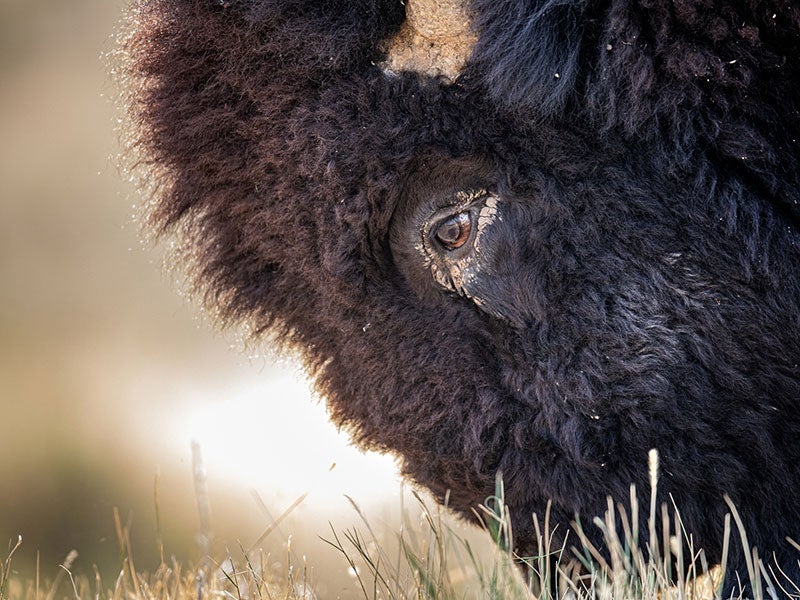How We Helped Bison Make a Huge Comeback
Earthjustice is using the power of the law to restore and recover wildlife — including bison.

In the middle of Montana, a group called American Prairie wants to see thousands of bison like this one roam free across America’s iconic prairie landscape.
Earthjustice is using its legal skills to make possible the vision of a great American bison comeback.
In the 19th century, white settlers and hunters brought bison nearly to extinction.
Yellowstone National Park, one of the last havens for wild bison, contained about two dozen individuals, the last wild bison in the United States. Together, they carried the fate of the entire species on their broad shoulders.
A coalition of conservationists and scientists set about to recover the American bison. They began breeding formerly wild bison found on private ranches with the Yellowstone herd.
As the population grew to almost 5,000, Yellowstone bison started crossing park boundaries. Some were captured and shipped to slaughter; others shot by hunters and state agents.
In 2001, Earthjustice began a series of legal battles that slowly carved out room to roam for the burgeoning Yellowstone bison population.
One of those fights resulted in a historic event for bison conservation. In 2012, after years of cattle interests blocking efforts by Native tribes in Montana to reestablish the bison herds that historically roamed their lands, Earthjustice’s litigation successfully defended the transfer of some of the last wild bison in Yellowstone to the Fort Peck and Fort Belknap Reservations in northern Montana.
“It was a return of wild bison to the people for whom the wild bison had meant everything,” says Earthjustice attorney Tim Preso, who began his legal career protecting bison.
After Earthjustice’s successful litigation, a new chapter of bison restoration began on the Great Plains where bison formerly roamed.
“When you have a people that have a history … with these magnificent animals, their absence has been felt tremendously. … And now that they’re back, our people are more centered,” says Stoney Anketell of the Fort Peck Tribal Board.
Now, American Prairie want to go further in returning more bison to their ancestral home.
For nearly 20 years, the conservation organization has been buying up private ranching land in Montana from willing sellers and connecting it to existing public lands. The group’s goal is to establish a 3-million-acre nature reserve with thousands of bison.
When bison thrive, so does everything else on the prairie.
As they forage for grass, their powerful hooves and hungry mouths manipulate the landscape so fundamentally that they turn back the clock on spring, lengthening the growing season and creating greener and more nutritious grasses overall. The impact is so dramatic, scientists can see it from space.
Bison foraging also creates ideal habitat for creatures like this prairie dog, which in turn feed coyotes and other natural predators.
Even in death, bison create new life. When left on the prairie, bison carcasses laden with seeds from wallowing in the dirt can eventually burst into clusters of wildflowers and new grass, which then attract birds, bees, and even pronghorn antelope.
But some Montana cattle ranchers don’t share American Prairie’s vision. Based on an unfounded fear that bison could transmit a disease called brucellosis to their cattle, local ranchers successfully pushed to invoke a draconian county ordinance that required all the bison to be captured and tested — a process so stressful that the bison can die from it.
That’s when attorneys from Earthjustice’s Northern Rockies office came in. They helped negotiate an agreement in 2021 that calls for American Prairie to test a representative subset of its bison herd and share information with the community. Members of the ranching community are also invited to attend all the handling events.
The plan is meant to build trust and find common ground between the two groups, and it’s already starting to work.
Bison restoration manager Scott Heidebrink says that the plan Earthjustice negotiated allows American Prairie to continue “providing a proof of concept for pragmatic rewilding in the 21st century.”
In 2022, the organization’s approach got another big win, after the Bureau of Land Management approved the organization’s plan to allow bison grazing on 63,000 acres of public lands in north-central Montana, a decision that Earthjustice is now defending in court.
If other large-scale rewilding projects are to succeed, American Prairie’s experience demonstrates that they must be able to adapt to or overcome significant cultural, economic, and legal barriers that make rewilding complex on the ground.
“We might view how to manage a resource a little differently, but the ranchers all love big, wide-open spaces. And they love wildlife,” says Heidebrink. “That was probably the most surprising thing to me is how much we actually all have in common.”
Earthjustice’s Northern Rockies office protects large, intact ecosystems and seeks to build ecosystem resilience by reducing pressures caused by oil and gas development, logging, road building, and off-road vehicle traffic. Learn more.
Written by Jessica A. Knoblauch, senior staff writer at Earthjustice.